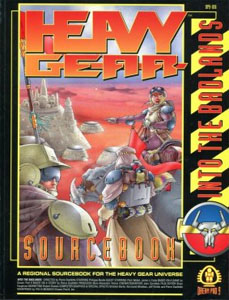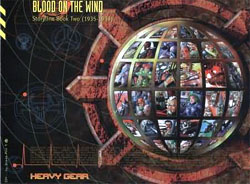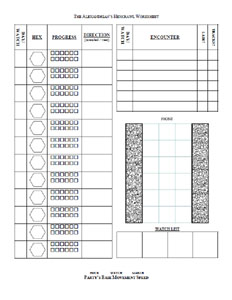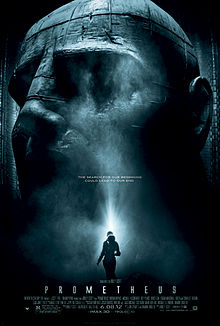Tagline: Into the Badlands was one of the first Heavy Gear supplements. It set the pace of excellence which we’ve come to expect from Dream Pod 9.
 There comes a point in reviewing Dream Pod 9’s work, I’ve realized, that you begin to run out of ways to say, “This is really great stuff.” After you’ve run through the synonyms of great, brilliant, sublime, creative, innovative, and brilliant (did I say that already?) you begin to worry that people will think of you as nothing but a broken record. I can almost hear your thoughts as you sit there reading through one review after another thinking, “This man has been bought off by Dream Pod 9. Nobody can be that good every single time.”
There comes a point in reviewing Dream Pod 9’s work, I’ve realized, that you begin to run out of ways to say, “This is really great stuff.” After you’ve run through the synonyms of great, brilliant, sublime, creative, innovative, and brilliant (did I say that already?) you begin to worry that people will think of you as nothing but a broken record. I can almost hear your thoughts as you sit there reading through one review after another thinking, “This man has been bought off by Dream Pod 9. Nobody can be that good every single time.”
Ah, but apparently they can.
Let me say it simply one more time: Dream Pod 9 is great. Heavy Gear is great. If you aren’t buying these books you’re missing out on a great thing.
To explain just how great these books are, let’s time travel back to the summer of 1997 and take a look around. In 1997 I’d been into roleplaying games for nearly a decade. Despite the fact that I still loved the games dearly and checked in on the Usenet newsgroups from time to time I hadn’t bought more than one or two roleplaying products in over two years. Nothing in the industry was really getting under my skin the way it used to and my interest was slowly waning.
In the summer of 1997 – nearly two years ago now as I write this – all of that changed. Despite having withdrawn my cash into other areas I had become aware of various titles over the years that had interested me to one degree or another: Feng Shui, CORPS, Theatrix… and Heavy Gear. None of them had caught me interest enough, however, to actually take the time to go out and buy them until one day I happened to spot the first edition of the Heavy Gear Rulebook on the shelf of the local hobby store. The cover, with its gear in extreme close-up, drew me in and the professional lay-out and clarity of the interior sold me. I bought the book there and then.
Over the next few days I devoured it in my free time. By the time I was finished I had become impassioned by roleplaying once again. I travelled back to the hobby store, but they didn’t stock any other Heavy Gear products at the time, so I picked up Feng Shui instead.
Heavy Gear brought me back to roleplaying, and its kept me here ever since. That’s how good it is.
All of which, in a rather roundabout manner, brings us to Into the Badlands — the latest Heavy Gear product I happened to read after running out of ways to say “buy this game dammit!”.
Into the Badlands is the sourcebook covering, as the name suggests, the Badlands: the broad equatorial deserts of Terra Nova. The Badlands are an excellent example of how Dream Pod 9’s ability to incorporate uncommon depth into their products gives the GM a broad palette and selection of tools in creating his adventures. Broadly speaking the Badlands are a mix of the American Wild West and the Middle East. If another company were handling this material it is easy to see how the Badlands would quickly be reduced to this common denominator. There would be a number of different cities, but at heart they would all be mere variations upon this simple theme.
Into the Badlands, on the other hand, takes the simple theme and (rather than simply varying it) begins creating whole new themes which are supported by the basic theme, but also subtly supplement it. Hence you get the frontier qualities of the desert oasis towers, you get the corporate politics of Peace River, you get the militaristic refugee community of Port Arthur, you get the visionary unity of Jan Mayen, you get the religious fervor of Massada, you get rover gangs and dueling circuits and smuggling cartels and gambling communities and polar influence and cold war and… well, you get a lot. Plus you get all the fringe areas where those different cultures come into contact and conflict with each other. All of which is supplemented by a plentiful amount of information about how life is actually lived on a day-to-day basis. (Ever sit down after reading a wonderful setting and realize that you have no idea how to actually get inside the mind of a character living in that setting because everything was dealt with at a macro-level? You’ll never have that problem with Terra Nova.) Tack on a couple of chapters on practical adventuring advice – including a dozen adventure seeds, some NPCs and archetypes, and a look at the creatures who make the Badlands their home – and you’ve got a well-rounded sourcebook.
About the only bad thing about the book is the lack of an index, but I could wax rhapsodic for a while longer about many things (like the way that they manage to cover everything you’d expect in a regional sourcebook, plus about twice as much that you wouldn’t – particularly in a book this size), but I won’t because it would be largely repetitious of my other recent reviews of Heavy Gear products. Buy the book.
Style: 5
Substance: 5
Author: Philippe R. Boulle
Company/Publisher: Dream Pod 9
Cost: $18.95
Page Count: 108
ISBN: 1-896776-02-7
Originally Posted: 1999/04/26
For an explanation of where these reviews came from and why you can no longer find them at RPGNet, click here.



